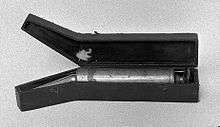Vaginal syringe

A vaginal syringe was an object used in the 19th century in the Western world for douching, treating diseases and for birth control. Vaginal syringes were fairly common at the time, but were not openly discussed because of taboos about discussing feminine hygiene.[1] Vaginal syringes were most often made of metal, glass or Bakelite.[2]
History
Vaginal syringes were marketed under various names, such as the ones made by the E. Edwards and Company of New York called "Lady's Friend" or the "Diamond Syringe No. 10."[3] It was important for manufacturers to be vague in advertising because they could be arrested on obscenity charges, like Ezra Heywood was for advertising a vaginal syringe in his newspaper in 1882.[4] His involvement in the issue led his wife, Angela Heywood to speak openly about birth control and feminine hygiene as a woman's "natural right."[5] Others, like Sarah Chase, were arrested for selling vaginal syringes as a method of birth control.[6] Vaginal syringes have been recorded in paintings by the 17th century artist, Jan Steen.[7] Women have created and patented vaginal syringes for use as birth control as early as the 1879 model developed by Ann Palmer.[8]
Treating disease and douching
Vaginal syringes were used to treat maladies such as leucorrhea or disease of the "pelvic viscera" by injecting water or water and chemicals into the vagina.[9] Vaginal syringes were also used to treat menstrual cramps.[7]
The vaginal syringe was also used to promote the Victorian notion that douching was an appropriate method of feminine hygiene.[10] By the 1930s, "many reputable gynecologists" were reporting that "habitual use of a vaginal syringe" was unhealthy.[11]
Birth control
The vaginal syringe as a method of birth control was available to women in the early nineteenth century.[12] In the 1860s, Henry Dyer Grindle, advocated using vaginal syringes for the application of spermicide into the vagina after sexual intercourse.[13] Women used different types of spermicides with the vaginal syringes including alum, chloride of zinc, baking soda, vinegar, borax, white oak bark, carbolic acid and other chemical combinations.[13] Some chemicals which could be used as a douche were "capable of inducing an abortion."[14]
See also
References
Citations
- ↑ Gannon, Megan (21 February 2014). "200-Year-Old Douche Found Under New York's City Hall". Live Science. Retrieved 24 March 2016.
- ↑ Williams, A.R. (29 March 2014). "11 Museum Surprises: Rediscovered Treasures, from a Celtic Brooch to an Early Hitchcock Film". National Geographic. Retrieved 24 March 2016.
- ↑ Fuller 2003, p. 181.
- ↑ Tone 2001, p. 37.
- ↑ Gordon 1973, p. 14.
- ↑ Tone 2000, p. 435.
- 1 2 "1800s Douche Found Under New York City Hall". The History Blog. 20 February 2014. Retrieved 24 March 2016.
- ↑ Stanley 1995, p. 273.
- ↑ Parker 1886, p. 8-9.
- ↑ Collins, Angela R. (12 March 2014). "A Lady's Syringe". The Office of the State Archaeologist. The University of Iowa. Retrieved 24 March 2016.
- ↑ Cox 1937, p. 157.
- ↑ Draznin 2001, p. 100.
- 1 2 Brodie 1994, p. 73-74.
- ↑ Bagley 2016, p. 142.
Sources
- Bagley, Joseph M. (2016). A History of Boston in 50 Artifacts. University Press of New England. ISBN 9781611689648.
- Brodie, Janet Farrell (1994). Contraception and Abortion in Nineteenth-century America. Cornell University Press. ISBN 9780801484339.
- Cox, Gladys M. (1937). Clinical Contraception (2nd ed.). London: William Heinemann. ISBN 9781483225487.
- Draznin, Yaffa Claire (2001). Victorian London's Middle-class Housewife: What She Did All Day. Westport, Connecticut: Greenwood Press. ISBN 9780313313998.
- Fuller, Wayne E. (2003). Morality and the Mail in Nineteenth-Century America. Board of Trustees of the University of Illinois. ISBN 9780252091353.
- Gordon, Linda (1973). "Voluntary Motherhood; The Beginnings of Feminist Birth Control Ideas in the United States". Feminist Studies. 1 (3): 5–22. JSTOR 1566477. (subscription required (help)).
- Parker, W. Thornton (1886). "Concerning Vaginal Injections". JAMA: The Journal of the American Medical Association. 6. Retrieved 24 March 2016.
- Stanley, Autumn (1995). Mothers and Daughters of Invention: Notes for a Revised History of Technology (Paperback ed.). New Brunswick, New Jersey: Rutgers University Press. ISBN 9780813521978.
- Tone, Andrea (September 2000). "Black Market Birth Control: Contraceptive Enterpreneurship and Criminality in the Gilded Age". The Journal of American History. 87 (2): 435–459. doi:10.2307/2568759.
- Tone, Andrea (2001). Devices and Desires: A History of Contraceptives in America. New York: Hill and Wang. ISBN 9780809038169.